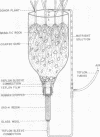Abstract
Collection of allelopathic chemicals from the undisturbed plant root system is difficult because of their low concentrations and the high level of contaminants in growth media such as soil. A new approach for the continuous trapping of quantities of extracellular chemicals from donor plants is described. Bigalta limpograss (Hemarthria altissima), a tropical forage with allelopathic activities, was established in sand culture. Nutrient solution was circulated continuously through the root system and a column containing XAD-4 resin. Extracellular hydrophobic metabolites were selectively adsorbed by the resin, while inorganic nutrients were recycled to sustain plant growth. Columns were eluted with methanol and the eluate separated into neutral, acidic, and basic fractions. Bioassays of trapped root exudates using lettuce seed combined with paper and thin layer chromatography showed that the inhibitors were mainly phenolic compounds. The active neutral fraction was methylated and analyzed by gas chromatography-mass spectrometry. Twelve compounds were identified, with two additional compounds tentatively identified. 3-Hydroxyhydrocinnamic, benzoic, phenylacetic, and hydrocinnamic acids were the major rhizospheric compounds with known growth regulatory activities.
Inasmuch as the root system was undisturbed and the recovery of exudates was highly efficient compared to conventional solvent extraction methods, this trapping system should be useful for a wide range of studies that relate to the chemistry of the rhizosphere.
Full text
PDF





Images in this article
Selected References
These references are in PubMed. This may not be the complete list of references from this article.
- Bray H. G., Thorpe W. V., White K. The fate of certain organic acids and amides in the rabbit. 10. The application of paper chromatography to metabolic studies of hydroxybenzoic acids and amides. Biochem J. 1950 Mar;46(3):271–275. doi: 10.1042/bj0460271. [DOI] [PMC free article] [PubMed] [Google Scholar]
- Junk G. A., Richard J. J., Grieser M. D., Witiak D., Witiak J. L., Arguello M. D., Vick R., Svec H. J., Fritz J. S., Calder G. V. Use of macroreticular resins in the analysis of water for trace organic contaminants. J Chromatogr. 1974 Nov 6;99(0):745–762. doi: 10.1016/s0021-9673(00)90900-2. [DOI] [PubMed] [Google Scholar]
- Whittaker R. H., Feeny P. P. Allelochemics: chemical interactions between species. Science. 1971 Feb 26;171(3973):757–770. doi: 10.1126/science.171.3973.757. [DOI] [PubMed] [Google Scholar]



